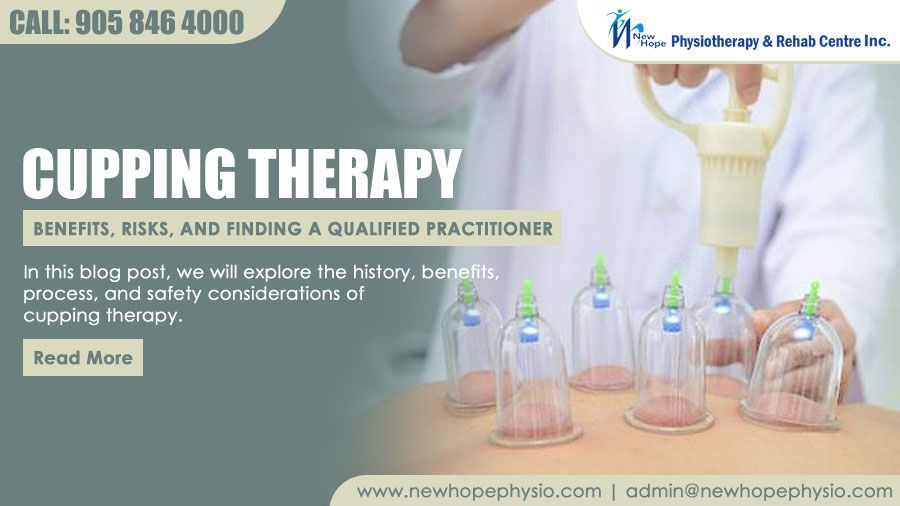
Welcome to the professional physiotherapy clinic
- Home
- Blog
Cupping Therapy: Benefits, Risks, and Finding a Qualified Practitioner
 8 May 2023
8 May 2023
Cupping Therapy: Benefits, Risks, and Finding a Qualified Practitioner
Cupping therapy is an ancient form of alternative medicine that has been practiced for thousands of years. This therapy involves placing cups on the skin to create a suction effect, which is said to promote healing and improve circulation. It has gained popularity in recent years, and many people seek it out as a natural and non-invasive way to treat various health conditions. In this blog post, we will explore the history, benefits, process, and safety considerations of cupping therapy. Whether you are a curious individual looking to try out cupping therapy or a health enthusiast looking to learn more, this post will provide you with valuable information on this ancient practice.
Brief history of cupping therapy
Cupping therapy is an ancient healing practice that has been used for thousands of years in various cultures around the world. It is believed to have originated in China, but it has also been used by ancient Egyptians, Greeks, and Middle Eastern cultures.
The earliest recorded use of cupping therapy dates back to around 3000 B.C. in Egypt, where it was used to treat a range of health conditions, including fever, pain, and digestive problems. It is also became popular in ancient Greece, where it was used by Hippocrates, the father of modern medicine.
Over time, cupping therapy spread to other parts of the world, including Asia and the Middle East. In traditional Chinese medicine, cupping therapy believed to balance the flow of energy or “qi” in the body and promote healing. In Islamic medicine, its used as a treatment for a range of conditions, including headaches, back pain, and respiratory problems.
Today, cupping therapy used by millions of people around the world, and it continues to be a popular alternative therapy for a range of health conditions. With a rich history spanning several thousand years, it has stood the test of time and remains a valuable tool for promoting health and wellness.
How cupping therapy works
Cupping therapy works by creating suction on the skin, which said to promote healing and improve circulation. The suction created by the cups draws blood to the surface of the skin and can help to increase blood flow, reduce inflammation, and relax muscles.
The theory behind cupping therapy rooted in traditional Chinese medicine, where it believed that the suction created by the cups helps to balance the flow of energy or “qi” in the body. According to this theory, it can used to treat a range of health conditions, including pain, digestive problems, respiratory issues, and skin conditions.
There are several different types of cupping therapy, including:
Dry cupping: In dry cupping, cups placed on the skin and left in place for several minutes. The suction created by the cups draws blood to the surface of the skin, which said to promote healing.
Wet cupping: Wet cupping involves creating small incisions in the skin before placing the cups. The suction created by the cups draws out small amounts of blood, which believed to help remove toxins from the body and promote healing.
Fire cupping: Fire cupping involves using a flame to create suction in the cups before placing them on the skin. This method can more intense than other types of cupping therapy and typically used for more severe health conditions.
Massage cupping: Massage cupping involves using cups in conjunction with massage techniques to promote relaxation, relieve pain, and improve circulation.
Overall, cupping therapy is a gentle and non-invasive way to promote health and wellness. While the theory behind it may not fully understood, many people have experienced the benefits of this ancient healing practice.
Health benefits of cupping therapy
Cupping therapy believed to have a range of health benefits, including:
Pain relief: It has shown to effective in reducing pain in a variety of conditions, including chronic neck and back pain, headaches, and fibromyalgia.
Improved blood circulation: The suction created by the cups helps to increase blood flow to the treated area, which can improve circulation and promote healing.
Reduced inflammation: It believed to reduce inflammation by increasing blood flow to the affected area and promoting the release of anti-inflammatory substances in the body.
Improved relaxation and stress relief: It believed to promote relaxation and reduce stress by stimulating the nervous system and releasing tension in the muscles.
Improved immune system function: It believed to improve immune system function by increasing the production of white blood cells, which help to fight off infections and disease.
Overall, cupping therapy can a valuable tool for promoting health and wellness, especially when used in conjunction with other forms of therapy and under the guidance of a qualified practitioner. While more research needed to fully understand the benefits of cupping therapy, many people have reported positive results from this ancient healing practice.
Cupping therapy process
Cupping therapy typically performed by a trained practitioner and involves the following process:
Consultation: Before the session, the practitioner will usually conduct a consultation to discuss your health concerns and determine if cupping therapy a suitable treatment for you.
Preparation: The skin in the treatment area cleaned and any hair shaved to ensure that the cups can applied properly. In some cases, the practitioner may also apply a lubricant to the skin to help the cups move more easily.
Cupping: The cups placed on the skin and suction created using a variety of methods, such as heat, pumps, or manual suction. The cups left in place for several minutes, during which time you may feel a sensation of pressure or warmth.
Removal: After the cups removed, the skin in the treatment area may gently massaged to help promote blood flow and reduce any discomfort.
Aftercare: Following the session, you may advised to rest for a short period of time and avoid strenuous activity for several hours. You may also advised to drink plenty of water to help flush out any toxins released during the treatment.
To prepare for a cupping therapy session, it important to wear comfortable. Loose-fitting clothing that can easily removed to expose the treatment area. You should also avoid eating a heavy meal before the session and avoid consuming caffeine or alcohol, as these can affect blood circulation.
After the session, it is important to take care of the treated area. And avoid exposing it to extreme temperatures or direct sunlight. You may also experience mild bruising or soreness in the treatment area, which should resolve within a few days.
Overall, cupping therapy is a safe and non-invasive way to promote health and wellness. However, it is important to consult with a qualified practitioner. And discuss any health concerns or medications you may be taking before undergoing the treatment.
Safety considerations
While cupping therapy generally considered safe, there are some potential risks and side effects to be aware of, including:
Bruising and skin irritation: Cupping therapy can cause temporary bruising or skin irritation in the treated area. In rare cases, more severe skin reactions such as burns or infections may occur.
Pain and discomfort: Some people may experience mild pain or discomfort during or after the cupping therapy session. Especially if the suction is strong.
Dizziness or nausea: In some cases, It can cause dizziness or nausea, particularly. If it performed on the neck or head.
Infection: If the cups not properly sterilized between sessions, there is a risk of infection.
Interference with medical conditions: It may interfere with some medical conditions or medications. So it is important to consult with a qualified practitioner and discuss any health concerns before undergoing the treatment.
People who should avoid cupping therapy include:
Pregnant women: It not recommended for pregnant women, as it may cause contractions or other complications.
People with skin conditions: It may exacerbate certain skin conditions such as eczema, psoriasis, or rosacea.
People with bleeding disorders: It may increase the risk of bleeding in people. With bleeding disorders or those taking blood thinning medications.
To find a qualified and licensed cupping therapist. It recommended to consult with a healthcare professional or to search for a practitioner. Who has undergone training and certification in cupping therapy. It also important to discuss any health concerns or medications with the practitioner before undergoing the treatment.
Conclusion
Cupping therapy is an ancient healing practice that involves creating suction on the skin using cups. While it believed to have a range of health benefits, including pain relief. Improved blood circulation, reduced inflammation, relaxation, and improved immune function. There also some potential risks and side effects to aware of, including bruising, skin irritation, pain, and infection.
Despite these risks, many people have reported positive results from cupping therapy. And find it to be a safe and effective way to promote health and wellness. However, it is important to consult with a qualified and licensed practitioner. And discuss any health concerns or medications before undergoing the treatment.
In conclusion, cupping therapy is a valuable tool for promoting health and wellness. But it is important to weigh the potential benefits. And risks and to seek out a qualified practitioner before undergoing the treatment. With proper care and guidance. It can a safe and effective way to support your overall health and well-being.
Recent Posts
All Categories
- Acupuncture
- Arthritis
- Back Pain
- Chiropractic
- Chronic Pain
- Cupping Therapy
- Exercise
- Fibromyalgia
- Headaches
- Health
- Injury Clinic
- Joint Pain
- K Taping Therapy
- Knee pain
- Laser Therapy
- Manual Therapy
- Massage Therapist
- Mental Health
- Neck Pain
- Nerve pain
- Orthotic
- pelvic floor physiotherapy
- Physiotherapy
- Sciatica Pain
- Scoliosis Exercises
- Shockwave Therapy
- Shoulder pain
- Sports Physiotherapy
- VRT



Leave a Comment